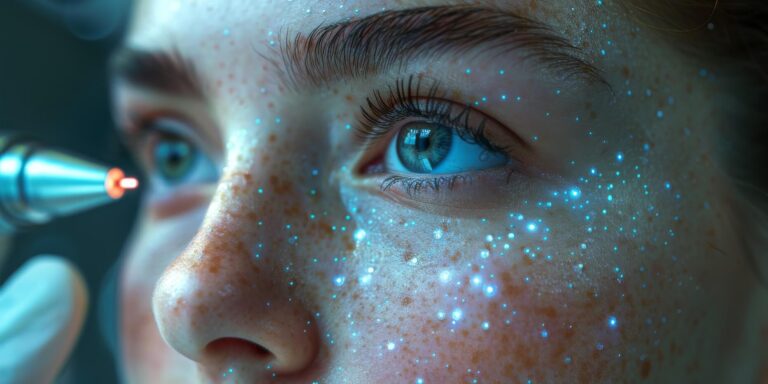What is Microdermal Abrasion?
Is a non-invasive aesthetic and facial rejuvenation treatment that uses a controlled exfoliation or abrasion system. It is one of the most popular and sought-after procedures in beauty centers
and aesthetic clinics due to its effectiveness and minimal downtime.
This treatment employs a specially designed device that projects a fine stream of tiny crystals or aluminum particles onto the skin. These abrasive particles, combined with gentle suction, gently remove the upper layers of dead cells, impurities, and damaged skin, revealing a smoother, softer, more radiant, and flawless complexion.
Is highly effective in improving the appearance of various skin conditions, including:
- Fine lines and wrinkles: Helps reduce the visibility of expression lines and superficial wrinkles, providing a smoother, more rejuvenated appearance.
- Spots and hyperpigmentation: Beneficial for lightening and diminishing the appearance of dark spots, melasma, and discolorations caused by sun exposure or aging.
- Superficial scars: Can improve the texture and appearance of mild scars, such as those caused by acne or minor injuries.
- Enlarged pores: Helps reduce the visibility of open pores and improve the overall skin texture.
- Sun damage: Effective in treating signs of photoaging, such as wrinkles, spots, and dryness caused by prolonged sun exposure.
In addition to deep exfoliation, it also stimulates the production of collagen and elastin, two essential proteins for maintaining skin firmness, elasticity, and a more youthful appearance.
One of the main advantages of this treatment is that it does not require prolonged downtime, and patients can resume their normal activities almost immediately after the procedure.
The advanced aesthetic equipment used in this treatment ensures precise control of the intensity and pressure applied, allowing the treatment to be adjusted according to each patient’s needs and skin sensitivity. This makes it a safe and suitable procedure for most skin types.

Benefits of Microdermal Abrasion
- Deep exfoliation: Removes dead cells and the upper layer of skin, revealing a fresher, more radiant complexion.
- Reduces imperfections: Helps diminish the appearance of fine lines, spots, scars, and enlarged pores.
- Collagen stimulation: Promotes the production of collagen and elastin, improving skin firmness and elasticity.
- Improves product absorption: Allows for better penetration of creams and topical treatments.
- No downtime: Does not require a prolonged recovery period.
How is the Microdermal Abrasion Treatment Performed?
The treatment is carried out at a beauty center or aesthetic clinic using a device specially designed for this purpose. The process is as follows:
- Skin preparation: The area to be treated is cleansed to remove any residual makeup or products.
- Device application: The professional gently moves the microdermabrasion handpiece over the skin, suctioning away dead cells while simultaneously applying a stream of abrasive particles.
- Intensity adjustment: The pressure and particle flow are adjusted according to the patient’s skin needs and sensitivity.
- Treatment completion: After covering the desired area, the skin is cleansed, and soothing and moisturizing products are applied.

Frequently Asked Questions (FAQ)
How long does a Microdermal Abrasion treatment take?
A treatment typically lasts between 30 and 60 minutes, depending on the area being treated and the patient’s specific goals.
Is the procedure painful?
Most patients describe microdermal abrasion as a sensation of exfoliation or a vigorous massage, but not painful. There may be slight discomfort or temporary redness after the treatment.
How many sessions are needed?
The recommended number of sessions varies depending on the skin condition and treatment goals, but generally, 4 to 6 sessions spaced 2 to 4 weeks apart are suggested for optimal results.
Who can undergo a Microdermal Abrasion treatment?
Is safe for most skin types and tones. However, it is not recommended for people with severe acne, eczema, rosacea, or other active skin conditions unless approved by a professional.
What aftercare is necessary?
After a microdermal abrasion treatment, it is important to apply broad-spectrum sunscreen and avoid excessive sun
What type of skin benefits most from Microdermal Abrasion?
Is effective for most skin types, but it tends to be especially beneficial for oily, blemished, or prematurely aged skin.
Can it be combined with other treatments?
Yes, can be combined with other aesthetic treatments such as chemical peels, intense pulsed light (IPL) therapy, or dermal fillers for more comprehensive results.
Is it safe for sensitive skin?
Although is generally safe, sensitive skin or certain conditions may experience more irritation or redness. In these cases, it is recommended to perform a patch test and adjust the treatment intensity.
How long should I wait between sessions?
The recommended interval between microdermal abrasion sessions is 2 to 4 weeks, depending on your skin’s response and treatment goals.
Can I wear makeup after the treatment?
It is recommended to avoid wearing makeup for at least 24 hours after the treatment to allow the skin to calm down and recover properly.
What are the contraindications of Microdermal Abrasion?
Contraindications may include pregnancy, active herpes, eczema, severe rosacea, sunburns, or any active skin condition. It is important to consult with a professional before the treatment.
Can Microdermal Abrasion remove deep scars?
While can help reduce the appearance of superficial scars, deeper and more severe scars may require more aggressive treatments such as dermabrasion or laser therapy.
Is it effective for treating acne?
Can be beneficial for treating mild to moderate acne as it helps remove dead cells and unclog pores. However, it is not recommended for severe acne or open lesions.
What’s the difference between Microdermal Abrasion and Dermabrasion?
Microdermal abrasion is a gentler and more superficial treatment that uses fine abrasive particles, while dermabrasion is a more aggressive procedure that employs a rotating wire brush to remove deeper layers of skin. Dermabrasion typically requires a longer recovery time.
Can Microdermal Abrasion be performed during pregnancy?
It is not recommended to undergo microdermal abrasion treatments during pregnancy, as hormonal changes can make the skin more sensitive and prone to irritation.
How much does a Microdermal Abrasion treatment cost?
The cost of a treatment can vary depending on the location, practitioner, and area being treated, but it generally ranges from $75 to $200 per session.
What is the best time of year for a Microdermal Abrasion treatment?
While it can be performed at any time of year, many experts recommend avoiding microdermal abrasion during the summer months when sun exposure is more intense, as the skin may be more sensitive after the treatment.
What precautions should I take after Microdermal Abrasion?
After the treatment, it is important to use broad-spectrum sunscreen, avoid excessive sun exposure, keep the skin well-hydrated, and use soothing products if there is redness or irritation.
Can I exercise after Microdermal Abrasion?
It is recommended to avoid strenuous exercise and activities that cause excessive sweating for at least 24 hours after the treatment, as this can irritate the newly exfoliated skin.
What is the best age to start Microdermal Abrasion treatments?
There is no specific age to start treatments, but many experts recommend starting in the early 30s when the first signs of skin aging begin to appear.
Can I have Microdermal Abrasion if I have vitiligo?
Is not contraindicated for people with vitiligo; however, it is recommended to consult with a professional to evaluate each case individually and adjust the treatment intensity as needed.
What kind of results can I expect after a Microdermal Abrasion treatment?
After a microdermal abrasion treatment, you can expect smoother, softer, and more radiant skin, with a reduction in the appearance of imperfections such as fine lines, spots, scars, and enlarged pores.
How long should I wait to see results after Microdermal Abrasion?
While some patients may notice an immediate improvement in skin texture and radiance, more significant results typically appear after several sessions, generally 4 to 6 weeks after the initial treatment.
Can I have Microdermal Abrasion if I have dry skin?
Can be beneficial for dry skin, as it helps remove dead cells and improve the absorption of moisturizing products. However, it is important to maintain proper hydration before and after the treatment.
What are the risks and side effects of Microdermal Abrasion?
Although is a relatively safe procedure, some common side effects may include temporary redness, mild peeling, sensitivity, or inflammation. More serious risks, such as infections or scarring, are rare when performed by a qualified professional.
Can I have Microdermal Abrasion if I’m taking medications?
Before undergoing a treatment, it is important to inform the professional about any medications you are taking, as some may increase skin sensitivity or interact with the procedure.
What should I do if my skin becomes irritated after Microdermal Abrasion?
If you experience irritation, excessive redness, or any other side effects after the treatment, you should contact your beauty professional immediately. Generally, it is recommended to apply soothing products and avoid sun exposure until the skin recovers.
How long should I wait after a Microdermal Abrasion treatment before undergoing another aesthetic procedure?
It is recommended to wait at least two weeks after a microdermal abrasion treatment before undergoing another aesthetic procedure, such as chemical peels or laser treatments, to avoid irritation or
Can I have Microdermal Abrasion if I have tattoos?
Although microdermal abrasion is generally safe for skin with tattoos, it is important to inform the professional and exercise caution when treating areas near tattoos, as they may become affected or faded.
What precautions should I take if I have hyperpigmentation?
If you have hyperpigmentation or dark spots on your skin, it is important to use broad-spectrum sunscreen and avoid excessive sun exposure after a microdermal abrasion treatment, as exfoliation can temporarily increase sensitivity to sunlight.
Can I have Microdermal Abrasion if I have melasma?
Can be beneficial for treating melasma, as long as it is performed with caution and under the supervision of a trained professional. It is recommended to avoid sun exposure after the treatment to prevent repigmentation.
How long does the effect of Microdermal Abrasion on collagen stimulation last?
Although stimulates collagen production, the effects are temporary and may last approximately 4 to 6 months. To maintain results, periodic maintenance treatments are recommended.
Can I have Microdermal Abrasion if I have deep wrinkles?
While can help reduce the appearance of fine lines and superficial wrinkles, deeper wrinkles may require more aggressive treatments, such as dermabrasion or dermal fillers.
In summary, this detailed article on microdermal abrasion and its frequently asked questions provides valuable information for those interested in this aesthetic treatment. Remember to always consult with a qualified professional before undergoing any procedure.



